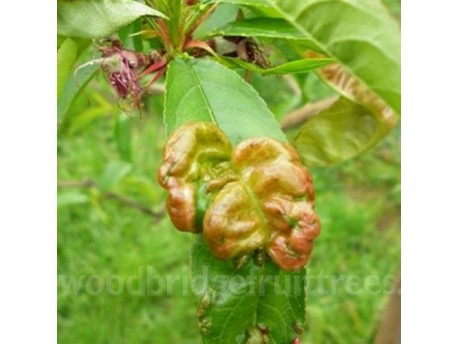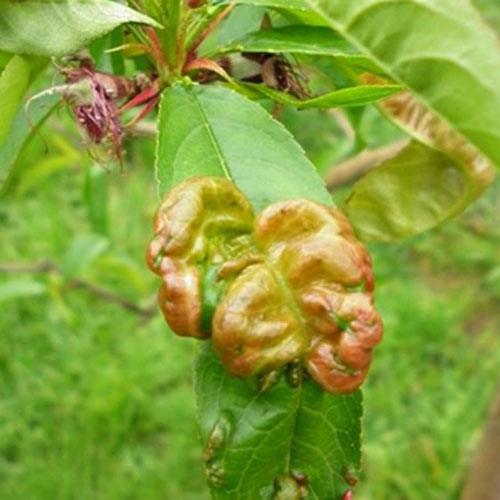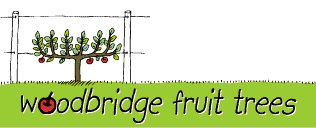No products
 View larger
View larger
Leaf Curl
 Leaf curl is a fungal infection that affects Nectarines and Peaches, and not only causes a deformity of the leaf, but can cause fruit rot. These fungal spores are prevalent everywhere, and when the conditions are right (cool and moist), these spores are swept into cracks in the bark adjacent to leaf buds by spring rain, and grow onto the leaves as they emerge. Some trees are only mildly affected and the tree can grow healthily despite this, while a large infestation may cause leaves to be so deformed as to prevent the tree making food from the sun.
Leaf curl is a fungal infection that affects Nectarines and Peaches, and not only causes a deformity of the leaf, but can cause fruit rot. These fungal spores are prevalent everywhere, and when the conditions are right (cool and moist), these spores are swept into cracks in the bark adjacent to leaf buds by spring rain, and grow onto the leaves as they emerge. Some trees are only mildly affected and the tree can grow healthily despite this, while a large infestation may cause leaves to be so deformed as to prevent the tree making food from the sun.
Fungal infections thrive where conditions are moist and remain moist without drying out. Trees planted in well ventilated areas tend to do better, while those in partial shade where moisture is trapped are more susceptible. Keep a tree pruned to increase air flow and remove affected leaf litter and fruit from where it has fallen in Autumn each year and burn it. In July spray the plant with Bordeaux or Burgundy mix - the copper and lime prevent the fungal spores from taking hold. Again, in mid August just before the leaf tips come out (the buds swell and become pinky) apply a second spray to the tree. It's not a cure, but if it reduces the amount of leaf curl.
Peter Cundal suggests this recipe:
Bordeaux Mix - 100g of copper sulphate dissolved in 5L of warmed water, and 100g of hydrated lime dissolved in 5L of water. Stir the lime to stop it settling and pour into the dissolved copper solution. Use within a few days. Do not spray on emerging leaves as it will damage them.
Burgundy Mix - Dissolve 100g of copper sulphate in 5L of warmed waster and 100g of washing soda (soda ash, or sodium carbonate used as a water softener) dissolved in 5L of warmed water. Mix together and spray - this mixture will less likely block the sprayer nozzle. Use within a few days. Do not spray on emerging leaves as it will damage them.
There are various forms of copper salts to choose from - they are all effective. Copper oxychloride, copper sulphate or copper hydroixide are examples. Use what is available. The ingredients are easily available in a hardware store.
If you're late in spraying your tree, at least get one spray in before leaf burst. Dont spray once the leaves have emerged, as the copper can damage the newly emerged leaves. Copper sprays are also useful for reducing rust in Raspberries, spraying at a similar time.
 Leaf curl is a fungal infection that affects Nectarines and Peaches, and not only causes a deformity of the leaf, but can cause fruit rot. These fungal spores are prevalent everywhere, and when the conditions are right (cool and moist), these spores are swept into cracks in the bark adjacent to leaf buds by spring rain, and grow onto the leaves as they emerge. Some trees are only mildly affected and the tree can grow healthily despite this, while a large infestation may cause leaves to be so deformed as to prevent the tree making food from the sun.
Leaf curl is a fungal infection that affects Nectarines and Peaches, and not only causes a deformity of the leaf, but can cause fruit rot. These fungal spores are prevalent everywhere, and when the conditions are right (cool and moist), these spores are swept into cracks in the bark adjacent to leaf buds by spring rain, and grow onto the leaves as they emerge. Some trees are only mildly affected and the tree can grow healthily despite this, while a large infestation may cause leaves to be so deformed as to prevent the tree making food from the sun.
Fungal infections thrive where conditions are moist and remain moist without drying out. Trees planted in well ventilated areas tend to do better, while those in partial shade where moisture is trapped are more susceptible. Keep a tree pruned to increase air flow and remove affected leaf litter and fruit from where it has fallen in Autumn each year and burn it. In July spray the plant with Bordeaux or Burgundy mix - the copper and lime prevent the fungal spores from taking hold. Again, in mid August just before the leaf tips come out (the buds swell and become pinky) apply a second spray to the tree. It's not a cure, but if it reduces the amount of leaf curl.
Peter Cundal suggests this recipe:
Bordeaux Mix - 100g of copper sulphate dissolved in 5L of warmed water, and 100g of hydrated lime dissolved in 5L of water. Stir the lime to stop it settling and pour into the dissolved copper solution. Use within a few days. Do not spray on emerging leaves as it will damage them.
Burgundy Mix - Dissolve 100g of copper sulphate in 5L of warmed waster and 100g of washing soda (soda ash, or sodium carbonate used as a water softener) dissolved in 5L of warmed water. Mix together and spray - this mixture will less likely block the sprayer nozzle. Use within a few days. Do not spray on emerging leaves as it will damage them.
There are various forms of copper salts to choose from - they are all effective. Copper oxychloride, copper sulphate or copper hydroixide are examples. Use what is available. The ingredients are easily available in a hardware store.
If you're late in spraying your tree, at least get one spray in before leaf burst. Dont spray once the leaves have emerged, as the copper can damage the newly emerged leaves. Copper sprays are also useful for reducing rust in Raspberries, spraying at a similar time.
Reviews
No customer reviews for the moment.

